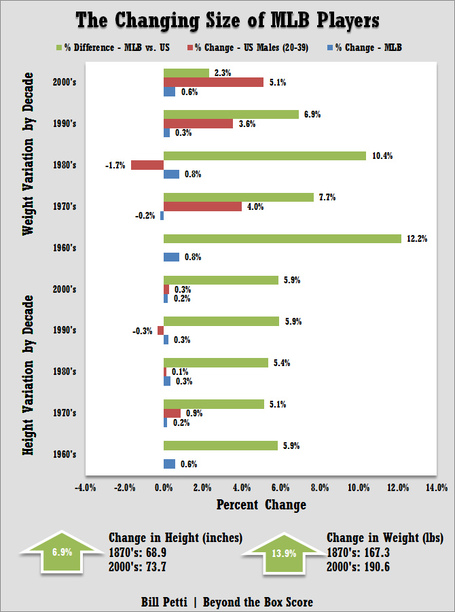Originally Posted by Bum:
jac, due to "height inflation" the small percentage "under 5'10" would be players only 5'6" or 5'7". Those guys, if they could play, were deemed middle infielders long ago. Your stats seem to imply sub-6 footers represent only 4.5% of the population of pitchers. The percentage is much, much higher, probably 35%, especially if you count 6-footers who have "rounded up" their height.
Height inflation is mostly just going to move the whole curve. Everyone under about 6'5" (for baseball, anyway) is rounding up. And it's sub 5'10" (not 6') guys that make up the 4.5%, per BBREF heights.
Originally Posted by PGStaff:
jacjacatk,
Where can one find that information? The first MLB All Star Game was played in 1933.
One thing about these size discussions. The size we talk about seems to change. When talking about athletics my guess is the average professional athlete is bigger than the average person. Guess in my mind, players under 6' and pitchers under 6'1 would be considered smaller types. I suppose if we used a number like 5'5 it would be very difficult to put together a list of great players under 5'5. It's not difficult at all to list great players 6'0 or less.
Same thing with weight. I don't know what the average weight of a male is, but I would guess it is quite a bit different than the average weight of a professional athlete/baseball player. For sure the average condition of the body would be much better and stronger among athletes.
As interesting as this stuff is to talk about... It's really a waste of brain cells.
Weight's a whole different issue with regards to data, since BBREF (baseball-reference.com) weights bear little relation to reality, especially for guys in their 30s who've been in the league for a while. See David Wells at 187, for instance.
It's an absolute certainty that the average MLB player is bigger than the average US (or whatever population you want to define from which MLBers are drawn) male. Despite what many here seem to be arguing, I don't know how you can do anything but conclude that that is a result of a selection process that wouldn't favor larger players if larger players didn't have an advantage.
Originally Posted by bballman:
Not really sure why we're talking about the percentage of sub 6 footers anyway. 1st, it is not something that anyone can change. If you want it bad enough and you are good enough, there are plenty of examples of sub 6 footers to prove that it is possible. Secondly, we have had plenty of people on here state that decision makers at the higher levels value the taller guys. Therefore, the pool of pitchers will favor what the decision makers, in general, value. So, as long as the decision makers see the taller players as a better bet, there will be more taller players playing at the higher levels. It's just the way it is. Once again, if a shorter player wants it enough and is good enough, it is still possible for that player to make it.
The topic started here was are there numbers out there anywhere that compare the statistics of taller pitchers vs shorter pitchers. It may be a good idea to look at these at the HS or college level or at whatever level prior to height being considered a determining factor, by at least a majority of the decision makers.
Does anyone here think that taller pitchers are naturally more durable or more effective off the bump than shorter pitchers? Is there really a quantifiable REASON that the decision makers value the taller pitcher over the shorter pitcher?
That taller pitchers are over-represented versus the MLB population on the All-Star team is quantifiable evidence that they perform relatively better. That decision makers with billions of dollars on the line chose bigger players disproportionately to their representation in the general population is evidence of the same.
Look, I'm not denying that there are great players of smaller stature. I'm suggesting that baseball talent is positively correlated with size, and I think there's an immense amount of data to back that up.
Contrary to some other suggestions in this thread, I think within the MLB population size is probably less of factor than across the whole population of baseball players including all the amateur ranks. This is because at the MLB level, everyone has been "selected" for talent and success, so you'd actually expect the smaller guys who are capable to effectively catch up some. At lower levels, and here I'm thinking specifically of HS and below, raw size (and the accompanying strength) can do more to make up for talent gaps, especially given that talent is much less evenly distributed. This is why, for instance, the 12u man-children win Cooperstown and the LLWS so much.


